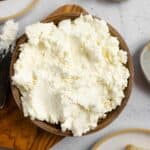How To Make Easy Homemade Ricotta Cheese
Homemade ricotta cheese is rich, but fluffy, full of flavor, but light in texture.
Servings: 8
Ingredients
- 4 ½ cups whole milk
- 1 ½ cups heavy whipping cream
- 1 teaspoon salt
- 3 tablespoons distilled white vinegar
Instructions
- Heat milk, heavy cream, and salt in a large pot over medium-high heat. Stir often with a wooden spoon so the milk mixture does not scald.
- Upon reaching 185 degrees Fahrenheit, you should see the beginning of a low boil. Stir in the vinegar just enough for it to be evenly distributed, then turn off the heat.
- Let the pot sit for 3-4 minutes undisturbed. You will see the mixture beginning to curdle.
- Line your strainer with cheesecloth, then place it over a large bowl.
- Carefully pour the curds and whey into the strainer, or ladle the curds in with a slotted spoon, then let it sit for one hour.
- At this point, you can choose to strain the ricotta in the refrigerator for another hour, or go ahead and use it. The longer it strains, the thicker it will become.
- Once it's right where you like it, you can use it right away or store it in an airtight container in the fridge.
- Pour the whey into a glass jar and keep in the refrigerator for other uses (ideas below!).
Video
Notes
- Ultra-pasteurized milk will not curdle, and most organic milk is ultra-pasteurized, so check the labels before choosing an organic milk for this recipe.
- Unsurprisingly, your ingredients will have an impact on the results. Ricotta made with whole milk and cream will have a different texture than ricotta made with straight 2% milk.
- I used white vinegar, but you can swap it out for fresh lemon juice, bottled lemon juice, apple cider vinegar, or even white wine vinegar. Just make sure the acid you are using is somewhat fresh, as old ingredients can hinder the curdling in some circumstances.
- Don't boil your ricotta very long. You want to bring your mixture to temperature and not boil past that. Too much heat can result in rubbery rather than soft ricotta. While it is natural for ricotta to have a grainy texture, it should still be a soft graininess, not like little grains of rubber.
- Strain the ricotta to your personal preference. For a thicker, drier result, go for the full 2 hours. I've heard of good results after even 20 minutes of straining, particularly if you want a creamier consistency. It's whatever you like best! If your ricotta ends up being thicker or drier than you like, simply add a splash of the whey back in and gently stir.
- The leftover whey can be kept for other uses, and any milk solids that made it through the cheesecloth can be added right back into the ricotta if desired.
- To strain the ricotta more thoroughly, you can use multiple layers of cheesecloth.
- If you don't have cheesecloth, try using a tea towel, a nut milk bag, or even a yogurt strainer if you are a yogurt maker.
